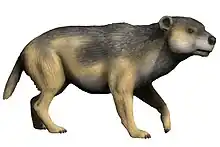Ursoidea
Ursoidea is a superfamily of arctoid carnivoran mammals that includes the families Subparictidae,[1][2] Amphicynodontidae,[3][2] and Ursidae which the last family includes the extant lineages of bears as well the extinct Hemicyoninae[4][5] and Ursavinae.[6] The interrelationships of ursoids has had slight arrangements. In the past it was thought the extinct Amphicyonidae were stem-bears based on morphological analysis of the ear region,[7] though the most recent publications on early amphicyonids suggests they were basal caniforms.[8][9][10] The amphicynodontids are sometimes classified as either a subfamily of bears,[3] a paraphyletic assemblage of early bears,[2] or even stem-pinnipeds.[11][12][13] The subparictids were previously classified as amphicynodontine/ids.[2] The hemicyonines have been occasionally reclassified as a separate family.[14]
| Ursoidea Temporal range: Bartonian - Present | |
|---|---|
 | |
| Life reconstruction of Cephalogale shareri | |
%252C_Viiksimo%252C_Kainuu_region%252C_Finland%252C_16_June_2018_(43094873292).jpg.webp) | |
| Brown bear (Ursus arctos) | |
| Scientific classification | |
| Domain: | Eukaryota |
| Kingdom: | Animalia |
| Phylum: | Chordata |
| Class: | Mammalia |
| Order: | Carnivora |
| Parvorder: | Ursida |
| Superfamily: | Ursoidea Fischer von Waldheim, 1817 |
| Families | |
References
- Baskin, J. A.; Tedford, R. H. (1996). Small arctoid and feliform carnivorans. pp. 486–497. doi:10.1017/CBO9780511665431.025. ISBN 9780521433877.
{{cite book}}:|journal=ignored (help) - Wang, Xiaoming; Emry, Robert J.; Boyd, Clint A.; Person, Jeff J.; White, Stuart C.; Tedford, Richard H. (2022). "An exquisitely preserved skeleton of Eoarctos vorax (Nov. Gen. Et sp.) from Fitterer Ranch, North Dakota (Early Oligocene) and systematics and phylogeny of North American early arctoids (Carnivora, Caniformia)". Journal of Vertebrate Paleontology. 42: 1–123. doi:10.1080/02724634.2022.2145900. S2CID 259025727.
- McLellan, B.; Reiner, D.C. (1992). "A review of bear evolution" (PDF). International Association for Bear Research and Management. 9 (1): 85–96. doi:10.2307/3872687. JSTOR 3872687. S2CID 91124592. Archived from the original (PDF) on 2020-02-19.
- Louis De Bonis (2013). "Ursidae (Mammalia, Carnivora) from the Late Oligocene of the "Phosphorites du Quercy" (France) and a reappraisal of the genus Cephalogale Geoffroy, 1862". Geodiversitas. 35 (4): 787–814. doi:10.5252/g2013n4a4. S2CID 131561629.
- L. de Bonis (2011). "A new species of Adelpharctos (Mammalia, Carnivora, Ursidae) from the late Oligocene of the "Phosphorites du Quercy" (France)". Estudios Geológicos. 67 (2): 179–186. doi:10.3989/egeol.40553.181.
- Qiu, Zhan-Xiang; et al. (2014). "A Late Miocene Ursavus skull from Guanghe, Gansu, China". Vertebrata PalAsiatica. 52 (3): 265–302.
- Hunt Jr., Robert M. (2001). "Small Oligocene Amphicyonids from North America (Paradaphoenus, Mammalia, Carnivora)". American Museum Novitates (3331): 1-20. doi:10.1206/0003-0082(2001)331<0001:SOAFNA>2.0.CO;2. ISSN 0003-0082. S2CID 198160461.
- Hunt, Robert M., Jr. (2004). "Global Climate and the Evolution of Large Mammalian Carnivores during the Later Cenozoic in North America" (PDF). Cenozoic Carnivores and Global Climate. pp. 139–285. doi:10.1206/0003-0090(2004)285<0139:C>2.0.CO;2. S2CID 86236545. Archived from the original (PDF) on July 20, 2007.
{{cite book}}:|journal=ignored (help)CS1 maint: multiple names: authors list (link) - Morlo, Michael; Miller, Ellen R.; El-Barkooky, Ahmed N. (2007). "Creodonta and Carnivora from Wadi Moghra, Egypt". Journal of Vertebrate Paleontology. 27 (1): 145-159. doi:10.1671/0272-4634(2007)27[145:CACFWM]2.0.CO;2. ISSN 0272-4634. S2CID 86235694.
- Tomiya, Susumu; Tseng, Zhijie Jack (2016). "Whence the beardogs? Reappraisal of the Middle to Late Eocene 'Miacis' from Texas, USA, and the origin of Amphicyonidae (Mammalia, Carnivora)". Royal Society Open Science. 3 (10): 160518. Bibcode:2016RSOS....360518T. doi:10.1098/rsos.160518. PMC 5098994. PMID 27853569.
- Tedford, R. H.; Barnes, L. G.; Ray, C. E. (1994). "The early Miocene littoral ursoid carnivoran Kolponomos: Systematics and mode of life" (PDF). Proceedings of the San Diego Society of Natural History. 29: 11–32. Archived from the original (PDF) on 2012-09-22. Retrieved 24 July 2010.
- Rybczynski, N.; Dawson, M.R.; Tedford, R.H. (2009). "A semi-aquatic Arctic mammalian carnivore from the Miocene epoch and origin of Pinnipedia". Nature. 458 (7241): 1021–24. Bibcode:2009Natur.458.1021R. doi:10.1038/nature07985. PMID 19396145. S2CID 4371413.
- Berta, A.; Morgan, C.; Boessenecker, R.W. (2018). "The Origin and Evolutionary Biology of Pinnipeds: Seals, Sea Lions, and Walruses". Annual Review of Earth and Planetary Sciences. 46: 203–228. Bibcode:2018AREPS..46..203B. doi:10.1146/annurev-earth-082517-010009.
- McKenna, Malcolm C., and Bell, Susan K. 1997. Classification of Mammals Above the Species Level. Columbia University Press, New York, 631 pp. ISBN 0-231-11013-8